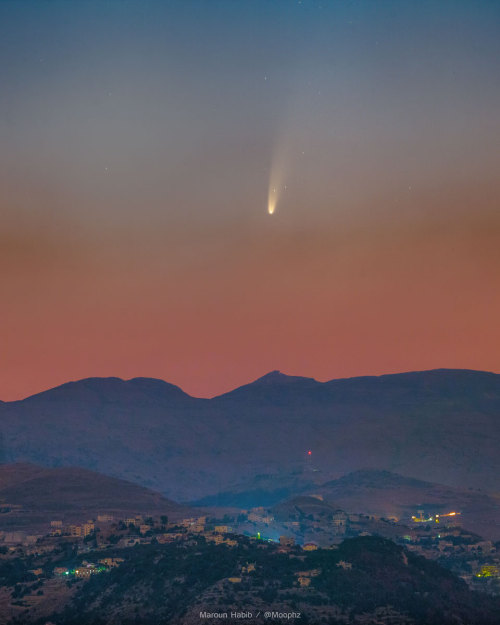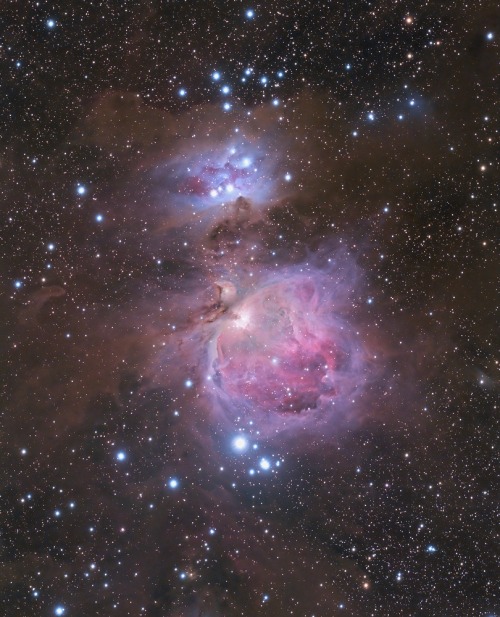High Definition Newly Taken Shots By NASA Mountain Olympus Mons On Mars, Its Twice As Tall As Mount Everest

High definition Newly taken shots by NASA Mountain Olympus Mons on Mars, its twice as tall as Mount Everest
More Posts from Chbnb and Others
![A 2.5 Hour Exposure Of The Rho Ophiuchi Region From A Dark Sky Site [OC]](https://64.media.tumblr.com/1a5bff34ca113731e5f11b514c05a43b/ceae70b7e5f929a7-49/s500x750/bae71af47f92f5b6a94db6fcda8cf7a597bea482.jpg)
A 2.5 Hour Exposure of the Rho Ophiuchi Region From a Dark Sky Site [OC]

Cone and Foxfur Nebulae

I gave a try at shooting the sky above my new house around Nice, France. That's a 10s exposure. Quite satisfied as light pollution is not as bad as what I thought.

Mineral Moon by Astrophotographer Andrew McCarthy

2020 July 7
Comet NEOWISE over Lebanon Image Credit & Copyright: Maroun Habib (Moophz)
Explanation: A comet has suddenly become visible to the unaided eye. Comet C/2020 F3 (NEOWISE) was discovered in late March and brightened as it reached its closest approach to the Sun, inside the orbit of Mercury, late last week. The interplanetary iceberg survived solar heating, so far, and is now becoming closer to the Earth as it starts its long trek back to the outer Solar System. As Comet NEOWISE became one of the few naked-eye comets of the 21st Century, word spread quickly, and the comet has already been photographed behind many famous sites and cities around the globe. Featured, Comet NEOWISE was captured over Lebanon two days ago just before sunrise. The future brightness of Comet NEOWISE remains somewhat uncertain but the comet will likely continue to be findable not only in the early morning sky, but also next week in the early evening sky.
∞ Source: apod.nasa.gov/apod/ap200707.html

Cepheus. Cosmic Zoo

IC 1805, Within The Heart

Needle In A Haystack
by Johnny Kim

The Orion Nebula (M42), M43 and the Running Man Nebula.
Credit: Chad Quandt

Rippling dust and gas lanes are what give the Flaming Star Nebula its name. The orange and purple colors of the nebula are present in different regions and are created by different processes. The bright star AE Aurigae, visible toward the middle of the image to the left, is so hot it is blue, emitting light so energetic it knocks electrons away from surrounding gas. When a proton recaptures an electron, red light is frequently emitted (depicted here in orange). The purple region's color is a mix of this red light and blue light emitted by AE Aurigae but reflected to us by surrounding dust. The two regions are referred to as emission nebula (the orange portion) and reflection nebula (the purple portion).
Pictured here in the Hubble color palette, the Flaming Star Nebula, officially known as IC 405, lies about 1500 light years distant, spans about 5 light years, and is visible with a small telescope toward the constellation of the Charioteer (Auriga).
Image Credit & Copyright: Eric Coles and Mel Helm
-
 audreyhel liked this · 2 years ago
audreyhel liked this · 2 years ago -
 brokenpearl1 liked this · 2 years ago
brokenpearl1 liked this · 2 years ago -
 setonfire13 liked this · 4 years ago
setonfire13 liked this · 4 years ago -
 enmiarbol reblogged this · 4 years ago
enmiarbol reblogged this · 4 years ago -
 nerdcrusade liked this · 4 years ago
nerdcrusade liked this · 4 years ago -
 mego-jose liked this · 4 years ago
mego-jose liked this · 4 years ago -
 jay1976 liked this · 5 years ago
jay1976 liked this · 5 years ago -
 venus-girl reblogged this · 5 years ago
venus-girl reblogged this · 5 years ago -
 buttymcbuttface liked this · 5 years ago
buttymcbuttface liked this · 5 years ago -
 gingamc liked this · 5 years ago
gingamc liked this · 5 years ago -
 itsnotsonia reblogged this · 5 years ago
itsnotsonia reblogged this · 5 years ago -
 digestionmachine reblogged this · 5 years ago
digestionmachine reblogged this · 5 years ago -
 crazystarlitsky liked this · 5 years ago
crazystarlitsky liked this · 5 years ago -
 davidallemon reblogged this · 5 years ago
davidallemon reblogged this · 5 years ago -
 teslastar liked this · 5 years ago
teslastar liked this · 5 years ago -
 honeysuckletook reblogged this · 5 years ago
honeysuckletook reblogged this · 5 years ago -
 honeysuckletook liked this · 5 years ago
honeysuckletook liked this · 5 years ago -
 stokrboy67 liked this · 5 years ago
stokrboy67 liked this · 5 years ago -
 alloku reblogged this · 5 years ago
alloku reblogged this · 5 years ago -
 i-amworthy liked this · 5 years ago
i-amworthy liked this · 5 years ago -
 uncommonidea liked this · 5 years ago
uncommonidea liked this · 5 years ago -
 shehungthemoon liked this · 5 years ago
shehungthemoon liked this · 5 years ago -
 theminingengineer reblogged this · 5 years ago
theminingengineer reblogged this · 5 years ago -
 beardandbike reblogged this · 5 years ago
beardandbike reblogged this · 5 years ago -
 is-this-lit reblogged this · 5 years ago
is-this-lit reblogged this · 5 years ago -
 4434r liked this · 5 years ago
4434r liked this · 5 years ago -
 paulciccone liked this · 5 years ago
paulciccone liked this · 5 years ago -
 nuckingfutssiren reblogged this · 5 years ago
nuckingfutssiren reblogged this · 5 years ago -
 therodentqueen liked this · 5 years ago
therodentqueen liked this · 5 years ago -
 thestraightrazor reblogged this · 5 years ago
thestraightrazor reblogged this · 5 years ago -
 oraniblog reblogged this · 5 years ago
oraniblog reblogged this · 5 years ago -
 darkdraggon liked this · 5 years ago
darkdraggon liked this · 5 years ago -
 123boriz liked this · 5 years ago
123boriz liked this · 5 years ago
